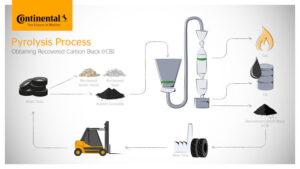Industrial Tyres are an often-overlooked market segment. However, without industrial tyres of all types, most logistics operations would grind to a halt. We asked Continental how important the industrial tyre market is, and how would they break the market down into specific sectors? (Forklift/ Tele-handling/ Crane tyres etc.)
Continental has a technical approach to industrial tyres
Continental replied; “The industrial tyre market is more than just a support system for heavy machinery — it is a reflection of economic movement. When industrial tyres are in use, it signals active logistics, construction, manufacturing, and infrastructure development. These tyres keep warehouses running, ports operating, and construction sites building — making them essential to the flow of goods and services in the global economy.
“As the industrial landscape evolves, so does the need for tyres that are not only tough and reliable but also smart and sustainable. Continental is at the forefront of this shift, investing in innovation across the entire tyre lifecycle, from material sourcing to end-of-life recycling.
 “We focus our resources on our strengths in Material Handling, Earthmoving, and Port Operations tyres to sharpen the direction of our Commercial Specialty Tires business — an area that holds significant value and strategic importance for Continental.”
“We focus our resources on our strengths in Material Handling, Earthmoving, and Port Operations tyres to sharpen the direction of our Commercial Specialty Tires business — an area that holds significant value and strategic importance for Continental.”
As a premium manufacturer Continental has both a range of experience and technology to develop the right tyres for the task at hand. In the case of industrial tyres how do they vary from sector to sector – obviously, a skid steer will have a different wear pattern to a forklift – for example.
Continental’s response was brief and to the point – Solid rubber tyres differ based on tread quality for a specific application. This is also supported by the construction and the chosen components to provide the right product for the respective intensity.
In solid tyres, what are to benefits of the different types of construction? Would you advise layered rubber construction, or solid tyres filled with bonded textile? What are the benefits and drawbacks of the various styles?
“In the area of solid rubber tyres, no reinforcing structures are used,” explained the company. “Except for the cores that ensure the necessary fit of the tyre on the rim, as is known from typical radial or diagonal tyres. Fibre reinforcement is used to modify specific compounds in their properties. The fundamental structure of a tyre consists of different layers of mixtures. By varying the composition and distribution of these materials, the performance characteristics—such as durability, load capacity, and wear resistance—can be significantly influenced.”
The demands on crane and telehandler tyres will vary from forklift or skid steer tyres. With that in mind, what are the key design features an operator should be looking for?
 Continental replied; “In the telehandler tyre segment, various constructions are available, including solid rubber and crossply tyres—each offering specific properties suited to different applications. In the crane tyre segment, the range becomes more complex, extending to radial tyres designed for higher-speed use on roads.”
Continental replied; “In the telehandler tyre segment, various constructions are available, including solid rubber and crossply tyres—each offering specific properties suited to different applications. In the crane tyre segment, the range becomes more complex, extending to radial tyres designed for higher-speed use on roads.”
Continental is one of the manufacturers at the forefront of digital technology and telematics in tyre use. How does Continental make use of RFID and TPMS technology in its industrial tyres?
“In the classic field of industrial tyres, digital solutions are currently only being used in very select applications,” explains Continental. “Here, the CPC ‘ContiPressureCheck‘ should essentially be mentioned, which is used in radial tyres to monitor the inflation pressure.”
How is Continental making its industrial tyres more sustainable? One might imagine there is a greater opportunity for recycled materials in industrial tyres compared to PCR/ TBR tyres.
“Sustainability is a growing priority, especially for industrial tyres, which use a high amount of rubber,” replies Continental. At Continental, we’re committed to making tyres more sustainable without compromising performance.
“Continental is continuously working to advance innovative technologies and sustainable products and services along the entire value chain – from the procurement of sustainable materials to the recycling of end-of-life tyres.
“The company has set itself the ambition of being 100 percent carbon neutral by 2050 at the latest with a milestone of 40% renewable and recyclable materials by 2030. We’re working across the entire value chain—from sourcing to recycling—to make this happen.”
- Recycled Materials: Continental already uses recycled rubber and recovered carbon black (rCB) in our materials. In its Material Handling (MH) segment, they are increasing the share of recycled and reclaimed materials and continuously researching new alternatives.
- Innovative Raw Materials: Continental is exploring sustainable sources like rice husk ash, rubber from dandelions, and recycled PET bottles to replace conventional materials.
- Retreading: While retreading is possible, it’s often limited due to transport costs and complexity. In many cases, recycling tyres and reusing the materials in new production is a more practical and sustainable solution.
Allied to the subject of sustainability is the core issue of recycling. How can your industrial tyres best be recycled?

Continental advised; “End-of-life tyre management is an important topic and a growing challenge across the world. At Continental, we view end-of-life tyres not as waste, but as valuable resources for sustainable production. Over recent years, significant advancements have been made in this area, and we continue to lead the way in developing circular economy solutions for the tyre industry.
“Our approach to industrial and OTR (Off-The-Road) tyres includes several key strategies:
“Retreading for Extended Tyre Life: We collaborate with specialist retreaders worldwide to ensure our industrial and OTR tyres are given a second life. The high retreading quality of our OTR casings is central to our resource efficiency and sustainability strategy. By retreading, we save up to 60% of the resources compared to producing a new tyre—an impactful contribution to reducing the industry’s environmental footprint.
“Smart Tyre Monitoring with ContiConnect: Our ContiConnect system, designed for OTR EM and Port tyres, plays a vital role in maximizing tyre lifespan. By monitoring inflation pressure and temperature, it helps prevent early carcass fatigue, ensuring tyres are used optimally and remain suitable for retreading.
“Material Recovery and Reuse: Continental has a long-standing commitment to integrating end-of-life tyres into the circular economy. At our retreading plant in Stöcken, Hanover, we not only retread truck tyres but also recover a material known as ContiReclaim. This reclaimed rubber is reintegrated into the production of new tyres, replacing fillers, polymers, and strength carriers—further reducing the need for virgin materials.
“Tailored Recycling Processes: Different recycling processes can yield various materials from used tyres, depending on factors such as tyre composition and intended reuse. These materials serve as sustainable substitutes in multiple applications, supporting our goal of reducing environmental impact while maintaining








